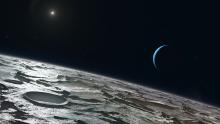Listen to today's episode of StarDate on the web the same day it airs in high-quality streaming audio without any extra ads or announcements. Choose a $8 one-month pass, or listen every day for a year for just $30.
You are here
Neptune III
The largest moon of the planet Neptune may have lost a twin. In fact, that may be why it orbits Neptune at all.
Triton is about 1700 miles in diameter — a bit smaller than our own moon. It’s one of 14 moons known to orbit Neptune, but the only one of any consequence — it’s about 300 times more massive than all the other moons combined.
Much of the surface of Triton looks like the wrinkled skin of a cantaloupe. It consists of frozen nitrogen atop a layer of water that’s frozen harder than granite. Geysers of nitrogen mixed with dust spew up to several miles high. Winds push the plumes across dozens of miles. The plume material then settles back to the surface, forming dark streaks.
Perhaps the most intriguing thing about Triton is its orbital motion: It orbits in the opposite direction from Neptune’s rotation. That suggests that it wasn’t born with Neptune, but that it was captured by the giant planet’s gravity.
It takes a special set of circumstances for that to happen, though. One possibility is that Triton had a companion. As the pair of them passed close to Neptune, though, the companion was stripped away and shot back into space, while Triton settled into orbit — giving Neptune its biggest moon.
And Neptune stands quite close to our moon tonight. The planet is shining at its brightest for the year. Even so, it’s still too far and too faint to see without a telescope. It looks like a tiny blue disk close to the upper left of the Moon.
Script by Damond Benningfield



